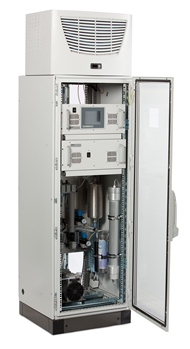Gasmet, the Finland based manufacturer of advanced gas analysis systems, will launch a new continuous mercury monitoring system (CMM) at Mercury 2013 in Edinburgh, Scotland (28th July – 2nd August).
Gasmet Europe’s Antti Heikkilä says “The CMM employs cold vapour atomic fluorescence (CVAF) to deliver very low detection limits at a significantly lower cost than other comparable mercury monitoring instruments.
“We have already installed systems in Finland and Poland, and initial users have been delighted with the CMM’s ability to measure low Mercury levels without cross-interference from gases such as Sulfur Dioxide. No separate chemicals, gold amalgamation concentrators, air scrubbers or additional gases are required, so operational costs are also very low.”
 New continuous mercury monitoring system (CMM).
New continuous mercury monitoring system (CMM).
Legislation to limit mercury emissions from combustion processes is progressing quickly in many parts of the world, but process managers have already started to implement mercury monitoring programs. Antti says “We have received enquiries from companies that need to prepare for compliance by better understanding their mercury emissions. However, we are also being contacted by process managers, for example from Sulfuric Acid manufacturing plants, who wish to control Mercury; not just in their emissions, but also in the end-product, by measuring directly in the process stream itself.”
The CVAF spectrometer has an integrated high temperature converter to effectively transform mercury compounds to atomic mercury without any chemicals or vulnerable catalyst materials. The close coupling of converter and fluorescence cell also ensures that Mercury does not recombine to, for example, Mercury Chloride between the converter and the Mercury Analyser. Sample gas dilution with synthetic nitrogen generated within the CMM system is an effective tool to promote sample transportation whilst decreasing the loss of Hg0 fluorescence signal to interactions with O2, CO2, and H2O. The fluorescence cell is specially designed to eliminate stray reflections and background light so that even with sample dilution the CMM system is capable of monitoring low levels of mercury as required in the forthcoming US Clean Air Mercury Rule.
The system is controlled through a touch screen control panel, which is integrated with the analyser and calibrator inside an air-conditioned cabinet, and calibration is maintained with regular automatic zero and span calibrations using Hg0 and HgCl2 calibration gases generated within the CMM system - typically every
24 hours. Periodic linearity checks with atomic mercury or mercury chloride are also possible.
The Gasmet CMM is now available from a worldwide network of subsidiaries and distributors; however visitors to Mercury 2013 (www.mercury2013.com) will be able to meet some of the Gasmet staff that have been involved in the development of this technology at stand No. 24.